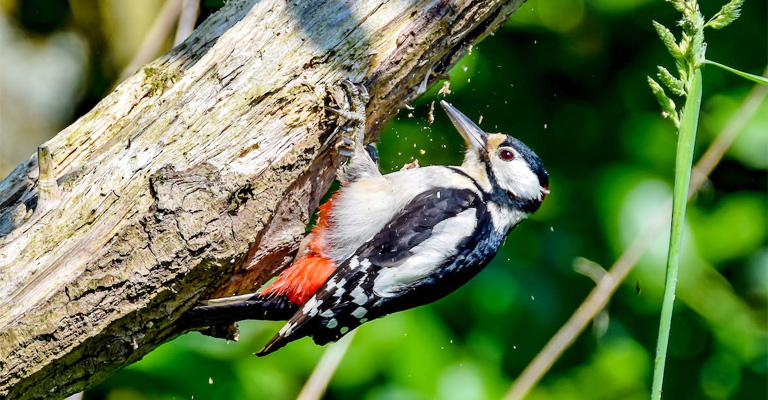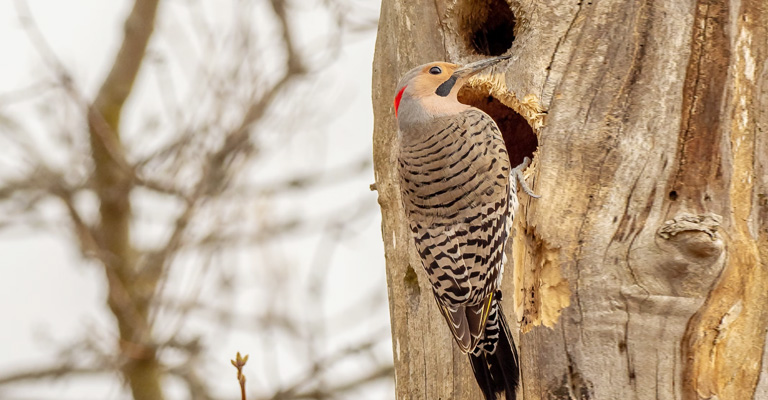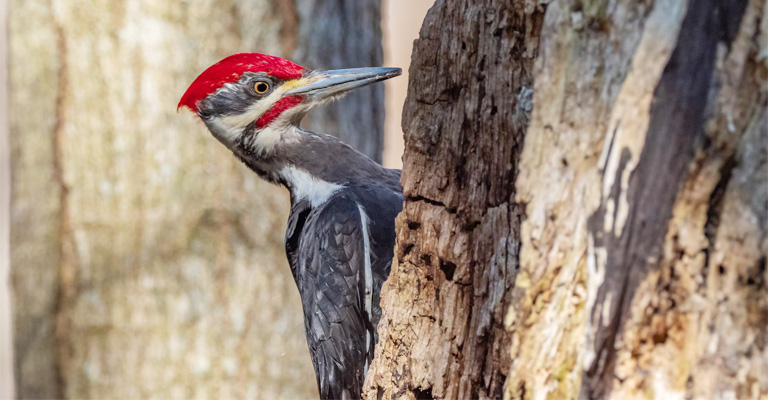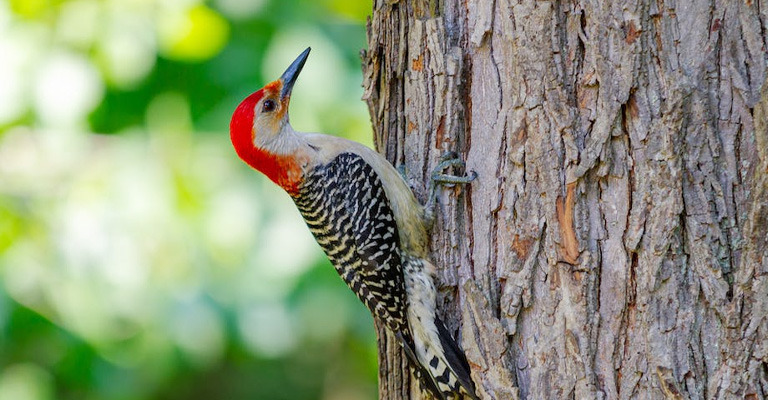The woodpecker, with its distinctive appearance and behavior, is renowned for its rapid and rhythmic pecking on tree trunks. This pecking serves multiple purposes, from foraging for insects to communicating with other woodpeckers.
Yet, what truly fascinates me is the astonishing speed at which a woodpecker can peck. “How fast can a woodpecker peck?” is a question that invites us into the mesmerizing world of these avian acrobats.
The answer lies in their unique adaptations, from specialized beaks and strong neck muscles to remarkable foraging techniques.
Each peck is a marvel of natural engineering, enabling woodpeckers to obtain sustenance and create nest cavities, all while minimizing the risk of injury.
In this exploration, we delve into the intricacies of woodpecker pecking speed and the remarkable mechanisms that allow them to perform their percussive symphonies on tree trunks.

How Fast Can A Woodpecker Peck?
A woodpecker’s rapid and rhythmic pecking is a marvel of nature, allowing it to excavate tree trunks and forage for insects. Several factors contribute to a woodpecker’s ability to peck quickly and efficiently:
Beak Design
The woodpecker’s chisel-like beak is a specialized tool designed for pecking. It is hard and pointed, allowing for precise strikes and minimizing damage to the skull.
Strong Neck Muscles
Woodpeckers have incredibly strong neck muscles that absorb the shock of each peck. These muscles act as shock absorbers, protecting the brain from injury during rapid pecking.
Skull and Brain Adaptations
The woodpecker’s skull is uniquely structured, with spongy bone and a small brain case. This design helps distribute the forces generated by pecking and prevents brain injury.
Feeding Technique
Woodpeckers employ a unique feeding technique. They strike the tree in a rhythmic fashion, with rapid, repeated pecks, which can exceed 20 strikes per second. This consistent pecking pattern allows them to access hidden insects efficiently.
Foraging Strategy
Woodpeckers are selective foragers, using their keen senses to locate insects and larvae beneath the bark of trees. Their ability to peck rapidly aids in uncovering concealed prey.
Tree Selection
The choice of tree and bark type also influences a woodpecker’s pecking speed. Softer wood or bark may allow for faster excavation, while harder surfaces may require more effort.
Environmental Conditions
External factors like the angle and stability of the tree trunk, as well as the wood’s moisture content, can affect a woodpecker’s ability to peck rapidly. Ideal conditions result in faster and more effective pecking.
Woodpeckers are masterful at adapting to their ecological niche, using their specialized physical features and unique behaviors to efficiently excavate trees and locate food sources.
These factors collectively contribute to their remarkable ability to peck rapidly while minimizing the risk of injury.
How Do Woodpeckers Peck?

Woodpeckers employ a variety of techniques when pecking, each serving specific purposes such as foraging for insects, establishing territories, or excavating nest cavities. Here are the ways in which woodpeckers use their pecking behavior:
Foraging Pecks
Woodpeckers use rapid, rhythmic pecks to forage for insects beneath the bark of trees. Their pecking is characterized by a steady sequence of strikes, allowing them to uncover hidden prey such as beetles and larvae.
Territorial Drumming
To establish and defend their territory, woodpeckers engage in territorial drumming. This involves delivering loud, rapid bursts of pecks on resonant surfaces like dead tree branches. The sound serves as an auditory signal to other woodpeckers.
Nesting Cavity Excavation
Woodpeckers excavate nesting cavities by pecking into the wood. These cavities serve as safe havens for raising their young. The pecking behavior is meticulous, and the wood chips are cleared away as the cavity deepens.
Communication Pecks
Woodpeckers use specific pecking patterns to communicate with one another. These patterns vary among species but can convey information about the bird’s presence, status, and readiness to mate.
Roosting Holes
Some woodpecker species create roosting holes, which they use for resting at night. These are typically shallower than nesting cavities and are used for temporary shelter.
Debarking
In their search for insects, woodpeckers may strip away pieces of bark from trees with their pecks. This exposes insects hidden in the bark, making them easier to capture.
Drumming to Attract Mates
During the breeding season, woodpeckers engage in drumming as part of courtship displays. These drumming sessions involve rapid and enthusiastic pecks on resonant surfaces and are meant to attract potential mates.
Woodpeckers are remarkably skilled at utilizing their pecking behaviors to communicate, find food, establish and maintain territories, and create safe nesting sites.
Their specialized adaptations, including their strong beaks, help them perform these activities effectively while minimizing the risk of injury.
How Hard Can A Bird Peck?

Birds, especially woodpeckers and other species adapted for pecking, can exert surprisingly forceful pecks. Here are some ways birds peck with force:
Wood Excavation
Woodpeckers, with their strong beaks, use powerful, rapid pecks to excavate tree bark and wood. These packs can be forceful enough to carve out nesting cavities, forage for insects, or create drumming sounds on resonant surfaces.
Impact Force
Birds like the Pileated Woodpecker can strike trees with an impressive impact force comparable to a small hammer. These forceful blows allow them to access hidden insects or establish territories by creating loud drumming sounds.
Nut Cracking
Some birds, including crows and parrots, use hard pecks to crack open nuts. Their powerful beaks are adapted to exert controlled force, allowing them to break open tough shells and access the nutritious contents inside.
Seed Extraction
Certain bird species, such as finches, use precise and forceful pecks to extract seeds from fruits or seed pods. They target specific areas to break open the seed’s protective coat and access the food source.
Predatory Strikes
Birds of prey, such as falcons and hawks, use strong, rapid pecks or strikes to deliver fatal blows to their prey. These precise and forceful attacks are aimed at vulnerable areas, ensuring a quick and efficient kill.
Defence Mechanism
Some birds, when threatened, use their beaks as a defensive weapon. For example, a mother bird may fiercely peck at a predator to protect her nest or young, delivering rapid and forceful blows to deter the threat.
Competitive Interactions
During territorial disputes or competition for resources, birds engage in forceful pecking displays. These aggressive pecks are meant to establish dominance, with rival birds using their beaks to intimidate and ward off competitors.
Birds’ ability to peck with force is a testament to their remarkable adaptations. Their beaks, varying in shape and strength based on their diet and ecological niche, allow them to employ different pecking techniques for survival, from foraging and feeding to defense and communication.
Which Trees Woodpecker Pecks?

Woodpeckers have a diverse palate when it comes to the types of trees they peck. Their choice of trees often depends on various factors, including the availability of insects, the condition of the wood, and regional preferences.
Here are some kinds of trees that woodpeckers may peck:
Hardwood Trees
Woodpeckers often target hardwood trees, such as oak, maple, and hickory, known for hosting a variety of insect species beneath their bark. These trees provide a rich source of food for woodpeckers, making them prime foraging sites.
Softwood Trees
Softwood trees, like pine, spruce, and fir, are also on the woodpecker’s menu. Although they may not harbor as diverse an insect population as hardwood trees, they can still provide a source of food, especially during certain seasons or in specific regions.
Deciduous Trees
Woodpeckers frequently peck at deciduous trees, which shed their leaves annually. The flaking bark of deciduous trees often conceals insects, larvae, and pupae, which woodpeckers target for their diet.
Conifer Trees
Some woodpecker species focus on conifer trees, particularly during winter when insect availability is lower. The pecking helps them access dormant insects within the crevices of the bark.
Dead or Dying Trees
Woodpeckers are often drawn to dead or dying trees, as they are more likely to host a thriving insect population. The soft, decaying wood of such trees is easier for woodpeckers to excavate.
Trees with Resonant Bark
For territorial drumming displays, woodpeckers prefer trees with resonant bark, which produces louder, more audible drumming sounds. These trees may include those with softer or more resonant wood.
Fruit Trees
Some woodpecker species, like Northern Flickers, may peck at fruit trees. While they are not seeking insects, in this case, they are after sap or sap-eating insects that are attracted to the sweet juices.
Woodpeckers’ choice of trees for pecking is diverse and dynamic, reflecting their adaptability to different environments and seasonal changes in insect availability.
These birds play essential roles in forest ecosystems by helping control insect populations and influencing the health of trees within their habitats.
FAQs
How fast can a woodpecker peck?
Woodpeckers can peck at an astonishing speed, often reaching around 20 pecks per second. This rapid pecking is essential for their foraging, communication, and nest excavation.
Do all woodpecker species peck at the same speed?
No, the pecking speed can vary among woodpecker species. Larger woodpeckers, like the Pileated Woodpecker, may have slightly slower pecking rates than smaller species, but all are remarkably fast and efficient at pecking.
What allows woodpeckers to peck at such high speeds?
Woodpeckers have evolved unique adaptations that enable rapid pecking. These include a strong, pointed beak, shock-absorbing neck muscles, and specialized skull structures that protect the brain from injury.
Why do woodpeckers peck at such high speeds?
Woodpeckers use rapid pecking for various purposes, including searching for insects hidden beneath tree bark, communicating with other woodpeckers through drumming sounds, and excavating nesting cavities in trees.
Can rapid pecking harm woodpeckers?
Woodpeckers are well-equipped to peck rapidly without causing harm to themselves. Their adaptations, such as the shock-absorbing system in their heads, protect their brains from the forces generated during pecking. Rapid pecking is essential to their survival and reproduction.
Conclusion
The world of woodpeckers, with their extraordinary ability to peck at astonishing speeds, is a testament to the incredible diversity of nature’s adaptations.
“How fast can a woodpecker peck?” is a question that unravels the mysteries of their behavior, from the precision of their beaks to the robustness of their neck muscles.
Woodpeckers employ their remarkable pecking skills for various purposes, including foraging, communicating, and excavating nest cavities. These birds serve not only as skilled insect hunters but also as drummers in the wilderness, marking their territories and signaling their presence to their peers.
Woodpeckers exemplify nature’s ingenuity, showcasing how evolution has shaped their bodies and behaviors to master the art of pecking with incredible speed and precision.